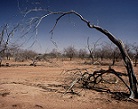Proactive drought management

Drought is a complex natural hazard which affects all climates and results in socio-economic impacts, the extent of which vary depending on several factors and conditions. Agriculture is the first and most drought affected sector. Direct impacts of drought include:
- reduced crop, rangeland, and forest productivity;
- reduced water levels;
- increased fire hazard;
- reduced energy production;
- reduced opportunities and income for recreation and tourism;
- increased livestock and wildlife death rates;
- Increased risks of land degradation; and
- damage to wildlife, forests and fish habitat.
A reduction in crop production usually impacts the livelihoods of local populations resulting in less income for farmers, hunger and mass starvation, increased food prices, unemployment, and migration. Responding to drought after the impacts have taken their toll is commonly referred to as crisis management. It is known to be untimely, poorly coordinated and ineffective.
Today, there is growing evidence that the frequency and extent of drought is increasing as a result of global warming.
FAO, jointly with the World Meteorological Organization (WMO), UNCCD and other partners, supports countries through well-coordinated national drought policies and the implementation of the related action plans. These include building the resilience and capacity of vulnerable sectors and planning emergency responses aligned with long-term development. This involves effective monitoring and early warning systems to deliver timely information to decision makers and to carry out effective impact assessments, pro-active risk management measures, and preparedness plans that incorporate emergency response programmes. Projects include the upscaling of climate-smart agricultural practices in drought prone landscapes and incentives for CSA at national and sub-national levels.
The drought policy approach
This is a methodology, a structure and a process for drought preparedness with the following inherent characteristics:
Integration, through joint planning by the concerned sectors
Decentralization as well as participatory planning and implementation
Synergy between the long-term development and the short-term emergency response to drought
Prioritization of mitigation and response measures
Timed, location-specific short and medium-term actions and measures, before during and after drought
Adaptation to climate change through resilience building
Sustainability of natural resources and environmental protection
Building on what exists using relevant tools and practices already in place for the different sub-sectors (crops, land, water, animal production, fisheries, forestry, etc.)
